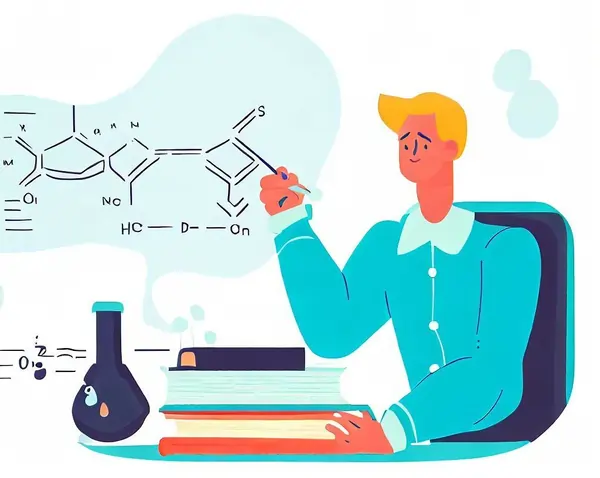Stoichiometry is a fundamental concept in chemistry, and it plays a crucial role in understanding the quantitative aspects of chemical reactions. Whether you're a high school student preparing to take your chemistry class or a college student pursuing a degree in chemistry, mastering stoichiometry is essential. In this comprehensive guide, we will delve into the intricacies of stoichiometry and provide you with the tools and strategies needed to tackle stoichiometry problems accurately on your exams.
Understanding Stoichiometry
Before we dive into solving stoichiometry problems, let's establish a clear understanding of what stoichiometry is. At its core, stoichiometry is the branch of chemistry that deals with the quantitative relationships between reactants and products in a chemical reaction. It helps us answer questions like:
- How much of a reactant is needed to produce a given amount of product?
- What is the theoretical yield of a product in a chemical reaction?
- How much of a reactant is left over after a reaction is complete?

Stoichiometry is based on the principle that chemical reactions occur in definite proportions, as defined by balanced chemical equations. A balanced chemical equation provides information about the ratios of reactants and products in a reaction. These ratios can be expressed in terms of moles, mass, or volume.
The Stoichiometry Roadmap
To master stoichiometry, it's essential to follow a systematic approach when solving problems. Think of it as a roadmap that will guide you through the problem-solving process. Here are the key steps to follow:
Step 1: Write a Balanced Chemical Equation
A balanced chemical equation is the foundation of stoichiometry. It tells you the ratios in which reactants combine and products are formed. Ensure that the equation is correctly balanced, with an equal number of atoms of each element on both sides.
Let's consider a simple example:
Balanced Equation: 2H₂ + O₂ → 2H₂O
Step 2: Identify Known and Unknown Values
Identifying known and unknown values is crucial for setting up the foundation of your stoichiometry problem. Known values are the pieces of information provided in the problem, such as masses, volumes, or concentrations. These serve as the starting points for your calculations. The unknown value represents what you need to find or calculate. Properly distinguishing between known and unknown values ensures that you focus your efforts on the right variables and maintain clarity throughout the problem-solving process, ultimately leading to accurate results on your stoichiometry exam.
Step 3: Convert Known Values to Moles
Converting known values to moles is a pivotal step in stoichiometry problem-solving. It allows you to work with a consistent unit (moles) for all substances involved in the chemical reaction. By converting grams, liters, or any other units to moles, you create a common ground that enables you to apply stoichiometric ratios effectively. This conversion simplifies calculations and facilitates precise determination of reactant quantities, setting the stage for accurate stoichiometry problem solutions on your exam. Remember to use the molar mass for solids and liquids and molar volume for gases when making these conversions.
Step 4: Use the Stoichiometric Ratios
Employing stoichiometric ratios is the heart of stoichiometry problem-solving. These ratios, derived from the balanced chemical equation in Step 1, determine how reactants and products are related in terms of moles. By applying these ratios, you can precisely convert between different substances and quantities in a chemical reaction. This step allows you to bridge the gap between known and unknown values, making it a pivotal point in solving stoichiometry problems accurately. A firm grasp of these ratios ensures you navigate the complexities of chemical reactions with confidence during your stoichiometry exam.
Step 5: Calculate the Unknown Quantity
In this step, you transition from establishing relationships between reactants and products to the heart of stoichiometry: calculating the unknown quantity. This step typically involves straightforward mathematical operations like multiplication or division, using the mole-to-mole ratios obtained from the balanced chemical equation. It's where you apply the stoichiometric relationships you've established to determine the precise amount of the substance you're trying to find. This critical step allows you to quantify the outcome of a chemical reaction accurately, an essential skill when tackling stoichiometry problems on exams or in real-world laboratory scenarios.
Step 6: Check Units and Sig Figs
Checking units and significant figures, is a vital checkpoint in stoichiometry problem-solving. In chemistry, units are as essential as numbers. Ensuring that your units match throughout the calculations guarantees the integrity of your final answer. Additionally, paying attention to significant figures helps maintain precision. The number of significant figures in your answer should reflect the precision of the data you started with. A careful review of units and significant figures not only prevents errors but also showcases your attention to detail and commitment to accurate results, an essential skill in mastering stoichiometry for exams.
Step 7: Include Units in Your Final Answer
In the final step of stoichiometry problem-solving, including units in your answer is absolutely essential. Units provide context and meaning to your numerical result. Chemistry, like all scientific disciplines, places a strong emphasis on precision and accuracy. Failing to include units in your final answer can render your work incomplete and ambiguous. Moreover, it's a simple yet critical practice that ensures you and others can correctly interpret the magnitude and dimension of your calculated value. Always remember that units are the language of science, making your answers universally understandable and scientifically valid.
Common Stoichiometry Scenarios
Understanding common stoichiometry scenarios is pivotal in mastering this fundamental chemistry concept. These scenarios, including limiting reactant problems, excess reactant problems, and percent yield calculations, represent real-world applications of stoichiometry principles. Proficiency in handling these scenarios equips you with problem-solving skills crucial for success in chemistry exams and practical applications.
Scenario 1: Limiting Reactant Problems
In a chemical reaction, the reactant that gets completely consumed is called the limiting reactant. This reactant determines the maximum amount of product that can be formed. Steps for solving limiting reactant problems:
- Calculate the moles of each reactant.
- Determine the mole-to-mole ratio from the balanced equation.
- Calculate the theoretical yield for each reactant.
- The reactant that produces the smallest theoretical yield is the limiting reactant.
Scenario 2: Excess Reactant Problems
To solve excess reactant problems, follow these steps:
- Identify the limiting reactant (use the steps from Scenario 1).
- Calculate the amount of the excess reactant that remains unreacted.
- Subtract the amount of the excess reactant consumed from the initial amount to find the remaining excess reactant.
Scenario 3: Percent Yield Problems
In real-world chemical reactions, the actual yield (the amount of product obtained) may be less than the theoretical yield (the amount calculated from stoichiometry). Percent yield is a measure of how efficiently a reaction produces the desired product. To solve percent yield problems, use this formula:
Percent Yield = (Actual Yield)/(Theoretical Yield)*100%
Scenario 4: Stoichiometry with Gases
When dealing with gases, you must consider the ideal gas law and molar volume at standard conditions (STP). The molar volume of an ideal gas at STP is approximately 22.4 liters/mol. Remember to convert between moles and liters when necessary.
Tips and Tricks for Success
Stoichiometry problems can be challenging, but with practice and the right strategies, you can excel on your stoichiometry exams.
- Master the Periodic Table- Familiarize yourself with the periodic table and the molar masses of elements. This knowledge is essential for calculating molar masses and converting between moles and grams.
- Practice, Practice, Practice- Stoichiometry is a skill that improves with practice. Work through a variety of stoichiometry problems to reinforce your understanding and problem-solving abilities.
- Keep Units Consistent- Consistency in units is crucial throughout stoichiometry calculations. Always double-check your units and make necessary conversions to ensure they match the desired units for the final answer.
- Use Dimensional Analysis- Dimensional analysis, also known as the unit factor method, is a powerful tool for stoichiometry calculations. It involves setting up conversion factors to cancel out units and arrive at the desired result.
- Understand Stoichiometric Ratios- A deep understanding of stoichiometric ratios from balanced chemical equations is key to solving stoichiometry problems accurately. Practice interpreting these ratios and applying them in calculations.
Sample Stoichiometry Problems
Sample stoichiometry problems serve as valuable learning tools to apply theoretical knowledge into practical solutions. By working through these problems, you can reinforce your understanding of stoichiometry concepts and develop problem-solving skills crucial for acing exams and solving real-world chemical equations accurately, building confidence in your chemistry journey.
Problem 1
How many grams of hydrogen gas (H₂) are needed to produce 36 grams of water (H₂O) according to the following balanced equation?
2H₂ + O₂ → 2H₂O
Solution:
Step 1: Write a Balanced Equation - Done.
Step 2: Identify Known and Unknown Values - Known:
36 grams of water; Unknown: grams of hydrogen gas.
Step 3: Convert Known Values to Moles -
To convert 36 grams of water to moles, use the molar mass of water (H₂O):
Molar mass of H₂O = 2(1.01 g/mol) + 16.00 g/mol = 18.02 g/mol
Moles of H₂O = (Mass (grams))/(Molar Mass (g/mol))= 36g/(18.02g/mol)=1.997mol
Step 4: Use the Stoichiometric Ratios
From the balanced equation, we know that 2 moles of hydrogen gas (H₂) are needed to produce 2 moles of water (H₂O).
Step 5: Calculate the Unknown Quantity
Moles of H₂ = 1.997 mol * (2 mol H₂)/(2 mol H₂O)= 1.997 mol
Now, convert moles of hydrogen gas to grams using the molar mass of hydrogen (H₂):
Molar mass of H₂ = 2(1.01 g/mol) = 2.02 g/mol
Grams of H₂=Moles of H₂ * Molar mass of H₂ = 1.997 mol *2.02 g/mol = 4.04 g
Answer: 4.04 grams of hydrogen gas are needed to produce 36 grams of water.
H3: Problem 2
What is the percent yield if a reaction produces 18.5 grams of carbon dioxide (CO₂) according to the following balanced equation, but the theoretical yield is calculated to be 21.0 grams?
CH₄ + 2O₂ → CO₂ + 2H₂O
Solution:
Step 1: Write a Balanced Equation - Done.
Step 2: Identify Known and Unknown Values - Known: Actual yield = 18.5 grams; Theoretical yield = 21.0 grams; Unknown: Percent yield.
Step 3: Calculate the Percent Yield -
Use the formula for percent yield:
Percent Yield = (Actual Yield)/(Theoretical Yield) * 100%
Percent Yield = 18.5g/(21.0g ) * 100% = 88.1%
Answer: The percent yield of the reaction is approximately 88.1%.
Conclusion
Stoichiometry is a critical skill in chemistry, and mastering it is essential for success on your exams. By following a systematic approach, understanding common scenarios, and practicing regularly, you can confidently tackle stoichiometry problems and take your stoichiometry exam with confidence. Remember that stoichiometry is not just about calculations; it's about understanding the relationships between reactants and products in chemical reactions. With dedication and practice, you can become a stoichiometry expert and excel in your chemistry studies.
